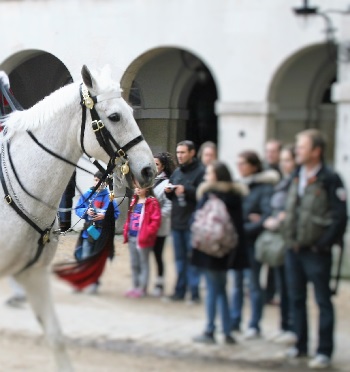
On duty: the face in the crowd that understands purposeful practice.
How to train a police horse
A long face in a match-day crowd led Richard Cheetham to explore a new source of inspiration for sports coaching and consider the real impact of purposeful practice.

On duty: the face in the crowd that understands purposeful practice.
On any match day at any of the grounds around the country you can see well-trained, calm and self-assured police horses standing head and shoulders above the crowd. With senses heightened, they are aware of their environment and the potential unpredictability that goes with major sporting events, almost immune to the threatening situations that may lie ahead. Their response to events shows a measured temperament and an almost symbiotic relationship with the rider, a relationship that has been built on trust and would literally allow them to jump through fire if needed.
As the final matches of the football season were being played I was drawn to learn more about the training these horses undertook. What were the key ingredients that went into developing such an ability to deal with potential hostilities, the noise, traffic and congestion caused by thousands of people? I sought and found a link to coaching and effective coaching practice.
The horse trainers talk of “gradually building the exposures” from the simplest action of opening and closing an umbrella in close proximity through to fire crackers and the presence of passing vehicles at varying speeds. The transformational effect this has is a testament to the detailed preparation of the horse in order to cope with a range of events, from ceremonial duties to protest marches. All this is achieved with purposeful training, accepting the individual nature of each animal, developing a strong relationship with the trainer, and recognition of both the internal and external obstacles that have to be faced.
The link and alignment with sports coaching then is there to be made and used to underpin the emphasis on relevancy in practice session design. Lakers and Chicago Bulls basketball coach Phil Jackson reflects on how he built successful teams and individuals. He refers to developing “character under fire”. The training philosophy was led by preparing players for the “inevitable chaos that occurs the minute they step onto the basketball court”. His equivalent to the opening and closing umbrella and fire crackers included practice sessions where there was a deliberate bias in the refereeing of scrimmages (informal training matches) unknown to the players. This was designed to gauge the individual’s response and their reaction under pressure, to retain focus and nurture the right temperament. The aim was an ability to adapt, to respond effectively and accept the uniqueness of each situation. If this the ability to adapt is the goal it is essential to develop ways of exposing athletes and players to real-game situations. Matthew Syed, well known for his book Bounce, comments on the quality of practice and refers to sessions that simulate specific situations likely to be faced as “purposeful practice” (often to referred to as deliberate practice).
How does this approach look in other coaching situations and where do you start to consider what purposeful practice is in reality? Examine and understand the competition demands, consider what will create the pressure that can affect performance and then modify sessions accordingly.
This was an idea that was introduced to training for a rugby union team that had just six games to play and a goal of avoiding the play-offs by achieving automatic promotion. Deteriorating pitches and the forecast for rain (and plenty of it) lay ahead. Welcome to the five-metre pressure grids: defending from the try line, attacking from five metres out. Play the conditions, train in the conditions with a focus on what the players are likely to face and how they need to cope. Move the training area to the worst part of the ground, overload the attacking team, involve all players regardless of their position and whether they may normally be ‘standing out’ from close contact areas. The focus was on ball retention, handling skills and decision-making in wet conditions.
Absolute attention to the right temperament formed the heart of the practice session and everything was designed to create the best conditions for success. Players were asked about the value of this purposeful practice and one stated after the match: “Right from looking out the window on the Saturday and seeing the rain, it was in my head that I could not just cope but perform well with conditions… The experience was in my mental locker.” This steely self-assurance was evident at a critical time of the season.
Adapting an understanding of ‘what it takes’ into a relevant practice is part of a coach’s duty, an obligation to teams and individuals that are preparing thoughtfully and thoroughly. Next time you go to a major event take time to look at the police horse and pay tribute to the coach who got them there. There are lessons to be learnt.
Richard Cheetham is a senior fellow in sports coaching at the University of Winchester.
The Leisure Review, September 2016
© Copyright of all material on this site is retained by The Leisure Review or the individual contributors where stated. Contact The Leisure Review for details.
![]() Download a pdf version of this article for printing
Download a pdf version of this article for printing